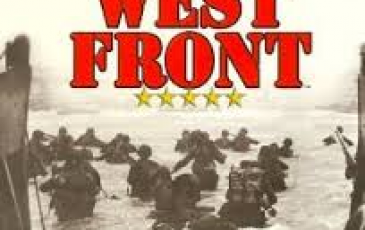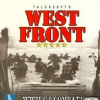Ortona: the Canadian´s Stalingrad - The Matrix Games version of West Front

| Rating: | 5.9 (5) |
| Games Played: | 5 |
| SM: | 6 |
| Turns: | 55 |
| Type: | Custom |
| First Side: | Allies |
| Second Side: | Germany |
| Downloads: | 19 |
20th December 1943
The Bernard Line was breached by crossing the Sangro River in November and the Commonwealth troops (2nd New Zealand, 8th Indian, 78 Inf, and the 1st Canadian) pushed forward until they met the next line of defense at the Moro River in early December. Here some of the bitterest fighting of the war took place; a fierce battle raged with the 8th Indian Division outflanking the Germans inland and the Canadians pushing up the coast. The Germans were expected to fall back on the next river line, but they had other plans. They meant to hold at Ortona. The German commander for Italy, Kesselring, ordered to the elite unit, the 1st Parachute Division, to hold Ortona at all costs. Ortona is typical of many Italian towns. In Medieval times it was a thriving Venician city with a harbor protected by a fortress on a promenade. The narrow streets and solid row houses formed a huge bunker. A gully to the northwest of the town kept the town from being locally outflanked. The 2nd Canadian Brigade approached Ortona from the southwest and began fighting their way into the town. By nightfall, the Edmontons had cleared the Church of Santa Maria di Constantinopoli after a stubborn fight. The next morning as the Canadians pressed into the "old Town" they found most of the streets heavily blockaded. They began to clear the Germans "house to house" with armor support following. The Germans would fortify a house by surrounding it with mined rubble and cover the approaches with fire lanes. When the bottom floor was taken the paratroopers would fight on in the upper stories. The Canadians tried to overcome these strong points by using anti-tank and assault gun fire as an instrument of demolition. When this was not possible the Canadians used a new wrinkle in house to house fighting known as "mouse-holing." Christmas Day was a cold and bleak time for the men of both sides since the fighting went on without respite. The city officially fell on December 28.
The Bernard Line was breached by crossing the Sangro River in November and the Commonwealth troops (2nd New Zealand, 8th Indian, 78 Inf, and the 1st Canadian) pushed forward until they met the next line of defense at the Moro River in early December. Here some of the bitterest fighting of the war took place; a fierce battle raged with the 8th Indian Division outflanking the Germans inland and the Canadians pushing up the coast. The Germans were expected to fall back on the next river line, but they had other plans. They meant to hold at Ortona. The German commander for Italy, Kesselring, ordered to the elite unit, the 1st Parachute Division, to hold Ortona at all costs. Ortona is typical of many Italian towns. In Medieval times it was a thriving Venician city with a harbor protected by a fortress on a promenade. The narrow streets and solid row houses formed a huge bunker. A gully to the northwest of the town kept the town from being locally outflanked. The 2nd Canadian Brigade approached Ortona from the southwest and began fighting their way into the town. By nightfall, the Edmontons had cleared the Church of Santa Maria di Constantinopoli after a stubborn fight. The next morning as the Canadians pressed into the "old Town" they found most of the streets heavily blockaded. They began to clear the Germans "house to house" with armor support following. The Germans would fortify a house by surrounding it with mined rubble and cover the approaches with fire lanes. When the bottom floor was taken the paratroopers would fight on in the upper stories. The Canadians tried to overcome these strong points by using anti-tank and assault gun fire as an instrument of demolition. When this was not possible the Canadians used a new wrinkle in house to house fighting known as "mouse-holing." Christmas Day was a cold and bleak time for the men of both sides since the fighting went on without respite. The city officially fell on December 28.
| Player Voting Stats | ||
|---|---|---|
| Member | Balance | Enjoyment |
| Moderately Pro Allies | 7 | |
| Moderately Pro Allies | 7 | |
| Slightly Pro Germany | 9 | |
| Slightly Pro Germany | 9 | |
| Totally Pro Germany | 3 | |
| Gaming Records | |||||||||
|---|---|---|---|---|---|---|---|---|---|
| 1st Side Player | 2nd Side Player | Result | Score | ||||||
 |
K K Rossokolski | vs. | Fierce |  |
Allies Major Loss | 12 | 72 | ||
 |
Valor | vs. | Secutor |  |
Allies Major Loss | 12 | 72 | ||
 |
Dragoon | vs. | LEGXXIIPRPF |  |
Draw | 36 | 36 | ||
 |
Sidorenko | vs. | kernel t |  |
Allies Major Victory | 72 | 12 | ||
 |
JOKipper | vs. | General Stymiest |  |
Allies Major Victory | 72 | 12 | ||
I believe that there are some OOB issues that must be rewritten. In such heavily defensible terrain, without heavy and medium arty Allies have to depend on light 25pdrs. Under Matrix it's very difficult to dislodge enemy from all thise trenches and bunkers.
Poor history. The OOB bears little arrangement to reality. The Allied reinforcemment arrangements are a jole.























